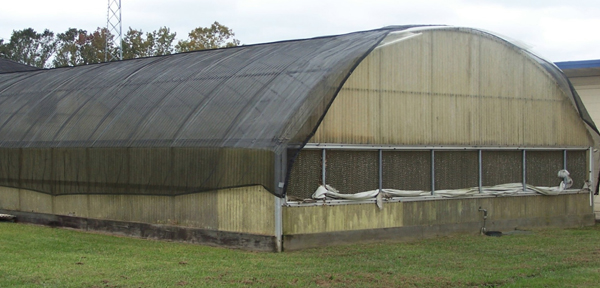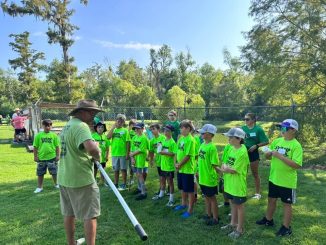
The greenhouse at the ARC of St. Charles is a multifunctional building that provides offseason tomatoes for local farmers’ markets and grocery stores while serving as an educational facility for local students, but it was not always this way.
The greenhouse was pretty much abandoned when County Agent Rene’ Schmit got a call from the ARC of St. Charles director back in 2005 asking if the LSU AgCenter had any use for the structure.
“I kind of thought about it a little bit and said that we were looking to provide offseason tomatoes to the farmers’ market. The farmers’ market was only in its third year at the time,” Schmit said. “The tomato season from May to July was about it for the market, so we needed some kind of supplement for that time. I thought greenhouse tomatoes was a thing to do.”
So Schmit and the LSU AgCenter decided to take on the project and bring the greenhouse back to life. The first thing they had to do was bring the structure up to the standard needed in order to run a proper operation. Schmit wrote a grant application to Dow Chemical Company and received $95,000 for the project. He used the funds to purchase materials to replace missing panels and install a heating and cooling system to ensure the temperature was properly regulated to maintain an optimal growing environment. He also installed a comprehensive irrigation system.
“We were one week away from starting and Katrina took care of that. We used the remainder of the grant to make repairs that took about a year to complete,” Schmit said.
Needless to say in the first growing season following Hurricane Katrina the greenhouse was not able to grow a crop and Schmit focused his energy on recuperating from the disaster. That did not matter much because Schmit still had to familiarize himself with proper greenhouse growing techniques.
“I really didn’t understand much at the time about how to grow greenhouse tomatoes,” he said. “The following year we did a test crop and the year after that we did it again,” he said. “We only had about 20 plants and were trying a different variety. Everything worked out to where we demonstrated we were getting a very good response.”
It was not until five years after first taking over the greenhouse that Schmit, and the River Region Master Gardeners he had recruited for help by that time, planted and saw their first full greenhouse full of tomatoes through to harvest.
“We went ahead with a full planting of the greenhouse in 2010. That was our first real planting that involved about 200 plants. We had success and have been doing the same thing each year thereafter,” Schmit said.
The initial plan was to get those with developmental disabilities associated with the ARC of St. Charles to assist in the gardening efforts. However, that proved to be too difficult.
“We were intending to do that, but actually that never really worked out because of training requirements that we would need to do effectively. However, I had four or five Master Gardeners that provided the work in planting trellising and so forth and the activities that were needed to produce the crop,” Schmit said.
Over the years Schmit and the Master Gardners have gotten very familiar with greenhouse gardening.
“We average 19 pounds of tomatoes per plant. The majority of these tomatoes we do collect are top grade,” he said. “We have four varieties that include what we call big beef series, including geronimo, quest, big dina and trust. These are hybrid tomatoes specifically formulated for greenhouse production.”
Very quickly after that first big crop the greenhouse started selling tomatoes in the local area and the first tomatoes went to the German Coast Farmers’ Market. They have been a hit ever since.
“The ARC tomatoes have gotten so popular that a lot of them are sold to other ARCs and local grocery stores,” he said. Schmit said they are sure not to run afoul of other growers who make a living off of their crops by ensuring they are only planting when no one else is.
“The tomato season is over by mid-July and you have several growers who have a fall crop where they plant in August. The fall crop will come in mid-October,” he said. “We start in October to have a supply of tomatoes March through May. We time it when we phase out in May so we are not in competition with the outfield growers.”
All of the proceeds from the tomato sales go back to pay for the greenhouse’s operation costs.
In addition to providing locally grown tomatoes during months when they would otherwise not be available, the ARC of St. Charles greenhouse also provides educational opportunities.
“The program has provided demonstrations for groups and students taking tours. We’ve had a quite a few teachers, administrators and other growers from other parishes that have started their own greenhouse business. We actually had a training we did with an individual who established their own greenhouse,” Schmit said.
Currently, Schmit and the Master Gardeners are preparing their next crop, which will take a few months.
“Within six weeks we get flowers developed and we pollinate the flowers using a electric toothbrush,” Schmit said. “As the plants grow and they are pollinated, they fruit and over a two month period so by the time we enter February we are picking ripe tomatoes.”
Schmit said he is very happy he answered the ARC’s call way back in 2005 and the greenhouse has exceeded his expectations in the different experiences it provides for those in the parish.
“What started out to be just simply an opportunity to provide for the farmers’ market has developed into many more opportunities,” he said. “It evolved to be something greater as an outdoor classroom for students, teachers and the public and by helping cultivate enterprises.”
Those who would like to find out more about the greenhouse or would like to help can do so by calling Rene’ Schmit at the LSU AgCenter at (985) 785-4473.




Be the first to comment